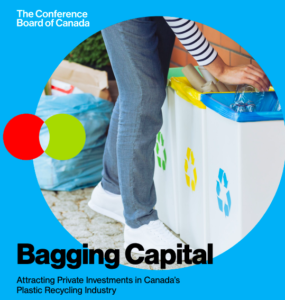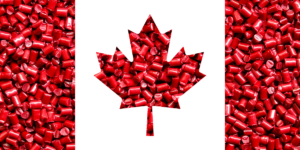Ontario inventor works to reimagine the typical plastic recycling process
Ontario inventor Wayne Conrad has designed a machine that doesn’t just recycle plastic, but turns it into finished goods that can be recycled again and again.
At only six- to eight-feet long, the device uses the same amount of power as an electric heater. It takes waste plastic, grinds it up, cleans it, extrudes it and ejects a molten sticky product that can be made into new materials — such as siding for houses or plastic paving slabs.
Conrad, the owner of about 600 patents and founder sustainable technology company Omachron, sees plastic as a resource, rather than waste. “I’ve always felt that we need to be sustainable,” says Conrad. “And I’ve always felt that sustainability can, in fact, be a way of making money.”
Conrad’s device uses 90 to 95 per cent less energy than standard recycling plants — and therefore costs less to run. “That has a profound impact on how little energy and cost is involved in taking old waste and making it straight into finished goods,” he says. The machine also recycles a variety of plastics — water bottles and plastic bags could be turned into plastic timber or roofing shingles. It can even recycle mixes of plastics.
Many conventional recycling machines currently use a technique called shear compression. Basically, there’s a barrel which squeezes and heats the plastic. But one of the problems with this is that, if there’s water vapour present, the water vapour creates bubbles and imperfections in the product. Conrad’s machine doesn’t use shear compression, rather it uses gentle heat, and any water vapour simply vents out. Gently heating the plastic also ensures that there aren’t any hot spots — areas of higher-than-average heat — which might degrade the plastic molecules. This means that the same plastic can be recycled at least 10 times over.
“We didn’t find at the end of the 10 times we couldn’t do it again,” Conrad adds, before chuckling. “It’s just I could only spend so much money in research.”
Conrad has been working on this technology for decades. “I was involved in it long before it was topical, but a lot of technology takes time to properly develop and to really bring to maturity,” says Conrad. “Now I’m just finishing and have been testing it long enough that I’m ready to release it to the world and am filing patents.”
Conrad’s goal is to bring sustainable manufacturing back to Canadian communities. He hopes that entrepreneurs can invest in his machine, allowing small businesses to recycle and create new products from waste products in their own communities. “Because we’ve made these machines small and inexpensive and quite lightweight, and easy to manage,” explains Conrad, “we’re going to see small entrepreneurs and small distributed manufacturing again. And we think that’s exciting because we’re creating jobs for a disenfranchised segment of the market.”
The key, notes Conrad, is thinking about plastic like an exchange. It’s a raw material that can move around between communities, as long as there are local entrepreneurs who can create products an area needs. Conrad says that against the backdrop of a greater societal conversation about sustainable plastic use, the world is ready for his company’s technology.
The plastic recycling machine is just one of Conrad’s inventions — he has patents pending for a plethora of exciting sustainable technologies, which will be announced in the coming months. “I was always optimistic that a time would come where there would be a pull into the marketplace for what we’re doing,” he says. “Years ago, when I talked to people about this, they just rolled their eyes and just thought I was a little bit, you know, out there. We’ve really got to do more with less: less energy, less material, less waste.”



